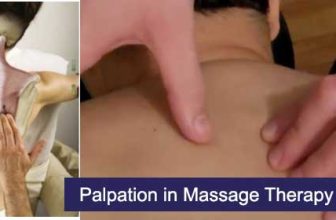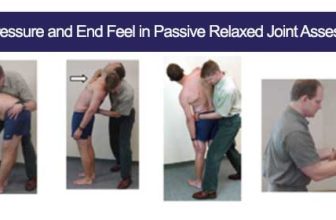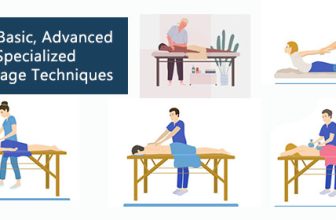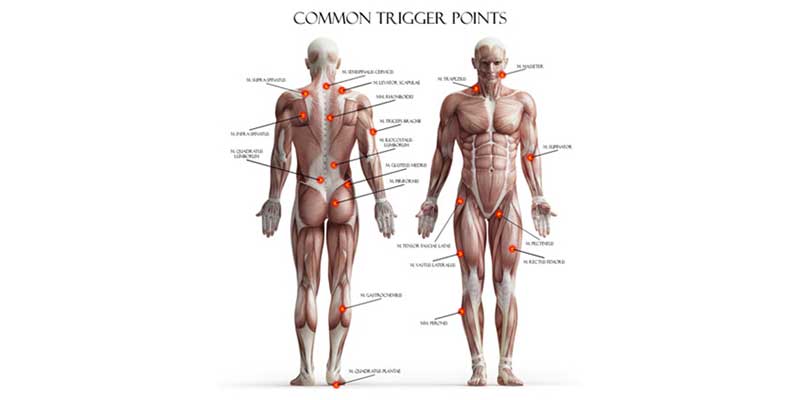
Trigger Point FAQs
Here are 11 frequently asked questions (FAQs) about Trigger Points and Trigger Point Therapy:
What are Trigger Points?
Trigger points are localized areas of tight muscle fibers that can cause pain and discomfort. They are often sensitive to pressure and can refer pain to other parts of the body.
Trigger points are specific areas of muscle tissue that are sensitive and may cause pain when pressed or overstimulated. They are commonly referred to as “knots” and are often associated with muscle tension, discomfort, and restricted movement.
Active Trigger Points: These are points that actively refer pain either spontaneously or with movement. They are often more tender and require targeted intervention.
Latent Trigger Points: Latent trigger points are less symptomatic but can become active and cause pain with certain movements or pressure.
What Causes Trigger Points to Develop? (10 Examples)
Trigger points can develop due to various factors, including muscle overuse, trauma, poor posture, stress, or repetitive motion or repetitive strain. They are often linked to muscle dysfunction and may contribute to chronic pain conditions.
Trigger points are associated with hyperirritability in muscle tissue, leading to localized muscle contractions and tenderness. They can contribute to muscle imbalances and altered movement patterns.
The causes of trigger points can vary, and they often result from a combination of factors. For Example:
- Muscle Overuse or Repetitive Stress
Example: Individuals who engage in repetitive activities or maintain fixed postures for extended periods, such as office workers, musicians, or athletes, may develop trigger points due to the constant demand on specific muscles. - Muscle Trauma or Injury
Example: Direct trauma, such as a muscle strain or injury from a fall, can lead to the development of trigger points. The affected muscle may react by forming trigger points as part of the healing process. - Poor Posture
Example: Prolonged periods of poor posture, such as slouching or maintaining an improper ergonomic setup, can contribute to muscle imbalances and the formation of trigger points, especially in the neck, shoulders, and upper back. - Emotional Stress
Example: Stress and emotional tension can manifest physically in the body, leading to muscle tightness and the development of trigger points. The neck, muscles of mastication/ TMJ, and shoulders are common areas affected by stress-related trigger points. - Lack of Physical Activity
Example: Sedentary lifestyles or insufficient physical activity can contribute to muscle stiffness and the formation of trigger points. Regular movement and exercise help maintain muscle health and reduce the risk of trigger points. - Nutritional Deficiencies
Example: Inadequate intake of nutrients, particularly vitamins and minerals essential for muscle function, can contribute to muscle dysfunction and trigger point development. - Sleep Disturbances
Example: Poor quality or insufficient sleep may contribute to muscle tension and trigger point formation. Muscles that are not allowed proper rest and recovery may become more susceptible to developing trigger points. - Dehydration
Example: Inadequate hydration can affect muscle flexibility and increase the likelihood of trigger points. Proper fluid intake supports overall muscle health. - Joint Issues
Example: Chronic joint problems or conditions that affect the biomechanics of the body can lead to muscle imbalances and trigger point development. - Referred Pain from Other Structures
Example: Pain or dysfunction in one part of the body may lead to compensatory movements and trigger point development in other muscles. For instance, a hip issue may result in trigger points in the lower back muscles.
How Can I Recognize a Trigger Point?
Trigger points are typically characterized by a palpable knot or nodule in the muscle, tenderness upon pressure, and the ability to reproduce referred pain when stimulated.
When pressure is applied to a trigger point, it often feels like a palpable nodule or tight spot within the muscle. This distinctive sensation is what therapists identify during massage sessions.
One characteristic feature of trigger points is the phenomenon of referred pain. When pressure is applied to a trigger point, it can cause pain to radiate or refer to other areas of the body. For example, a trigger point in the neck might cause pain in the head or down the arm.
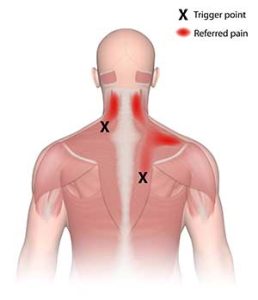
7 Trigger Point Symptoms and Effects
- Trigger points are characterized by localized muscle contractions, or knots. This contraction can lead to increased muscle tension and tightness in the affected area. The muscle may feel tense, and the individual may experience discomfort or pain.
- Muscle dysfunction caused by trigger points can result in a reduced range of motion. The affected muscle may not lengthen or contract properly, leading to limitations in movement. This can impact daily activities and contribute to feelings of stiffness.
- Trigger points can lead to muscle imbalances, where certain muscles become overactive and others may become weakened or inhibited. This imbalance can affect the biomechanics of the body and contribute to altered movement patterns.
- Active trigger points are often associated with pain, both at the site of the trigger point and in referred areas. The pain may be sharp, aching, or radiate to other parts of the body. This discomfort can interfere with daily activities and overall well-being.
- Trigger points can disrupt the normal functioning of a muscle. This disruption may include changes in the way the muscle contracts, relaxation difficulties, or even changes in muscle tone. These alterations contribute to the overall dysfunction of the muscle.
- Chronic trigger points can influence posture. Muscles with trigger points may become tight and pull on certain structures, leading to postural changes. For example, trigger points in the neck and shoulders may contribute to a forward head posture.
- To avoid pain or discomfort associated with trigger points, individuals may unconsciously adopt compensatory movements or postures. These compensations can lead to additional stress on other muscles and joints, creating a cycle of dysfunction.
What is Trigger Point Therapy?
Trigger point therapy is a massage technique that involves applying sustained pressure to specific trigger points to alleviate pain, release muscle tension, and promote healing.
The goal of trigger point therapy is to reduce muscle tension, alleviate pain, and improve range of motion and muscle function.
During your trigger point therapy session, the massage therapist will work on locating and releasing these trigger points using various techniques. They will apply focused pressure to the trigger points using their fingers, knuckles, or elbows, and may also incorporate stretching and deep breathing exercises. They will also be using various massage techniques to release tension in the surrounding muscle tissues.
Trigger point release techniques aim to deactivate or “release” the hyperirritable spot. This can be achieved through sustained pressure, stretching, massage strokes, or a combination of these methods.
Massage therapists often incorporate trigger point therapy into their sessions to help clients find relief from localized pain, improve muscle function, and promote overall relaxation.
Is Trigger Point Therapy Painful?
Trigger point therapy can sometimes cause discomfort or mild pain as the massage therapist works on these specific areas of tension. However, it is generally considered a “good” kind of discomfort, as it indicates that the therapist is targeting the source of your pain and working to release it.
Trigger point therapy may cause some pain during the treatment as the therapist applies pressure to the trigger points. However, the therapist will work within your comfort level and adjust the pressure accordingly.
Communicate openly with your massage therapist throughout the session. Let them know if the pressure is too intense or if you experience any sharp pain. They can adjust their techniques and pressure to ensure your comfort and maximize the effectiveness of the treatment.
How long Does a Trigger Point Therapy Session Typically Last?
The duration of a trigger point therapy session can vary depending on the specific needs and goals of the individual. Generally, sessions can range from 30 minutes to 60 minutes or more.
How Many Trigger Point Therapy Sessions Do I Need?
The number of sessions needed depends on various factors, including the severity of your condition, the number of trigger points, and your body’s response to the treatment. Your therapist will discuss a personalized treatment plan with you.
What Can I Expect After a Trigger Point Therapy Session?
After a trigger point therapy session, it is common to experience some soreness or tenderness in the treated areas. This discomfort should go away after a day. Many people also report a reduction in pain, improved range of motion, and an overall sense of relaxation immediately after treatment.
By addressing trigger points during massage therapy, therapists aim to alleviate pain, improve muscle function, and restore a more balanced musculoskeletal system. It can contribute to increased range of motion, reduced muscle tension, reduced pain and discomfort, and an overall sense of well-being.
Can I Perform Self-Trigger Point Therapy at Home?
Yes, there are techniques and tools available for self-trigger point therapy, such as using foam rollers, tennis balls, or specialized self-massage tools. However, it is recommended to consult with a qualified therapist to learn proper techniques and ensure safety.
Is Trigger Point Therapy Suitable for Everyone?
Trigger point therapy can be beneficial for many individuals, but it may not be suitable for everyone. People with certain medical conditions or injuries should consult with a healthcare professional before undergoing trigger point therapy to determine its appropriateness for their situation.
For more information, (from The American Academy of Family Physicians) see Trigger Points: Diagnosis and Management here: https://www.aafp.org/pubs/afp/issues/2002/0215/p653.html
